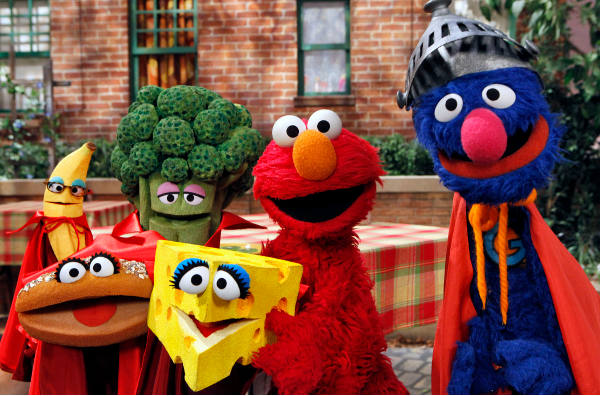Sesame Street celebrates its 43rd season this September. For over 40 years, it’s been harnessing the power of media to educate children, and there have been hundreds of studies that demonstrate the show’s effectiveness. Here are some of the research highlights:
Many studies with differing methodologies have highlighted the cognitive and academic benefits of viewing Sesame Street. For example, the first evaluations of the show indicated that children who were exposed to Sesame Street scored higher on letter, number and classification tests than non-viewers. The more children viewed, the greater their knowledge. [1]
Longitudinal studies have also shown that children who were frequent Sesame Street viewers at age two scored higher on standardized tests of school readiness in kindergarten than less-frequent or non-viewers[2] and that frequent Sesame Street viewing in preschool is associated with higher high school grade point averages even when controlling for several demographic factors.[3]
One recent study found that children in preschool classrooms which participated in a media-rich curriculum incorporating public television video and games (from Sesame Street, Super Why and Between the Lions) developed the early literacy skills critical for success in school. These foundational skills – being able to name letters, knowing the sounds associated with those letters, and understanding basic concepts about stories and print – all increased among the 4- and 5-year-olds in the study.[4]
Children who viewed Sesame Street segments also had the highest level of pro-social behaviors during planned and structured activities and were lowest in antisocial behaviors during free play (Zielinska & Chambers, 1995).[5]
[1] S. Ball and G.A. Bogatz. “The First Year of Sesame Street: An Evaluation” (Princeton, NJ: Educational Testing Service, 1970). S. Ball; G.A. Bogatz. “The Second Year of Sesame Street: A Continuing Evaluation” (Princeton: Educational Testing Service, 1971).
[2] J.C Wright et al. “The Early Window Project: Sesame Street Prepares Children for School.” In “G” is for “Growing”: Thirty Years of Research on Sesame Street. ed. S. Fisch and R. Truglio (Mahwah: Erlbaum, 2001), 97-114.
[3] A.C. Huston, et al. “Sesame Viewers as Adolescents: The Recontact Study,” “G” is for “Growing”: Thirty Years of Sesame Street Research (Mahway: Erlbaum), 131-143.
[4] Measures included naming letters, knowing sounds of letters, knowing concepts of story and print, and recognizing letters in own name. Penuel, W. R., Pasnik, S., Bates, L., Townsend, E., Gallagher, L. P., Llorente, C., & Hupert, N. (2009). Preschool teachers can use a media-rich curriculum to prepare low-income children for school success: Results of a randomized controlled trial. New York and Menlo Park, CA: Education Development Center, Inc., and SRI International.
[5] Zielinska, I. E. & Chambers, B (1995). Using group viewing of television to teach preschool children social skills. Journal of Educational Television 21, 85-99.

